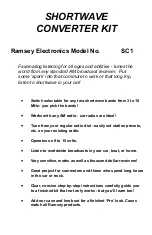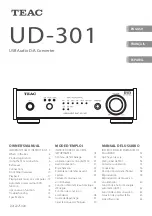
SC-1
•
15
UNDERSTANDING WHAT YOUR RADIO IS ACTUALLY TUNING
As mentioned in the SC1 circuit description, this converter is broadbanded,
meaning that there is no provision to pre-tune the antenna input to a
particular frequency band. This design poses little problem for casual
shortwave broadcast listening, but it would not be the right design for a
communications receiver relied upon for tuning weak, distant signals. At any
given time, your AM radio is actually giving you two shortwave frequencies at
the same time!
Let's say that you are listening to Radio Moscow on 11.840 MHz with your
radio dial set at 1000 KHz. This means that the SC1 oscillator (L1) is running
at 10.840 KHz. This means that your AM radio is also receiving the
difference of 10.840 MHz and 1000 KHz, which is 9.840 MHz, also a popular
shortwave broadcast band. It also means that you could hear the same
11.840 MHz broadcast with the SC1 oscillator tuned to 12.840 and that your
radio could also pick up signals on13.840 and so forth. You actually may use
this effect to your advantage in being able to tune in to two bands with one
oscillator setting!
NOTES FOR RADIO HAMS AND EXPERIMENTERS
The SC1 Shortwave Converter can be a fun "platform" for putting an extra
AM-radio set to work for listening to your favorite band. Brand-new AM-only
car radios pulled from new vehicles are easy and inexpensive to find. There
is ample room on the PC board for changes and add-ons of your own design,
but please be sure that you read and understand the Ramsey Kit Warranty
before undertaking any changes of the original circuit.
If you build a 455 KHz BFO for CW-SSB reception, its output may be
coupled to the output of Q2 and fed directly to the receiver antenna input. Or
you can design a BFO within the AM radio itself. There is also plenty of room
on the PC board for additional tuneable circuits, or you may wish a switching
arrangement for jumpers A-B and B-C.
If you are teaching a class on receiver fundamentals, the SC1 is easy to set
up to do some effective show-and-tell. In addition to the SC1, a 9 or 12-volt
DC supply, hi-fi or automobile receiver, and antenna, use the following for
your demonstration: solid-state signal generator (for BFO injection), a
Ramsey Frequency Counter (to display SC1 oscillator frequency), plus a test
signal of some kind such as a Ramsey QRP transmitter connected to a
dummy load. Your demonstration can teach the principles of mixing,
tuneable IF, what images are, and BFO injection.






































